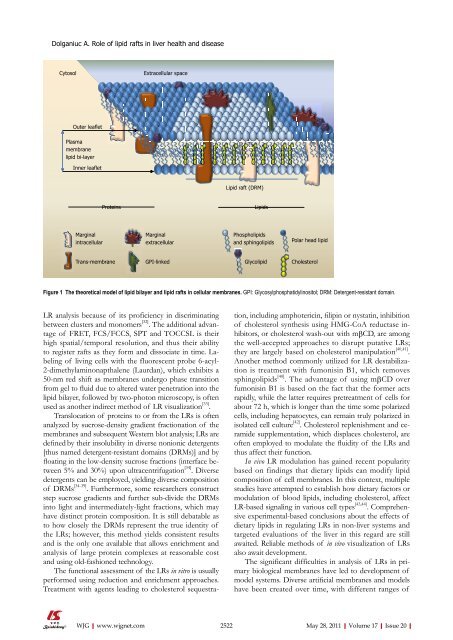20 - World Journal of Gastroenterology
20 - World Journal of Gastroenterology
20 - World Journal of Gastroenterology
You also want an ePaper? Increase the reach of your titles
YUMPU automatically turns print PDFs into web optimized ePapers that Google loves.
Dolganiuc A. Role <strong>of</strong> lipid rafts in liver health and disease<br />
Cytosol<br />
Outer leaflet<br />
Plasma<br />
membrane<br />
lipid bi-layer<br />
Inner leaflet<br />
Marginal<br />
intracellular<br />
Trans-membrane<br />
LR analysis because <strong>of</strong> its pr<strong>of</strong>iciency in discriminating<br />
between clusters and monomers [32] . The additional advantage<br />
<strong>of</strong> FRET, FCS/FCCS, SPT and TOCCSL is their<br />
high spatial/temporal resolution, and thus their ability<br />
to register rafts as they form and dissociate in time. Labeling<br />
<strong>of</strong> living cells with the fluorescent probe 6-acyl-<br />
2-dimethylaminonapthalene (Laurdan), which exhibits a<br />
50-nm red shift as membranes undergo phase transition<br />
from gel to fluid due to altered water penetration into the<br />
lipid bilayer, followed by two-photon microscopy, is <strong>of</strong>ten<br />
used as another indirect method <strong>of</strong> LR visualization [33] .<br />
Translocation <strong>of</strong> proteins to or from the LRs is <strong>of</strong>ten<br />
analyzed by sucrose-density gradient fractionation <strong>of</strong> the<br />
membranes and subsequent Western blot analysis; LRs are<br />
defined by their insolubility in diverse nonionic detergents<br />
[thus named detergent-resistant domains (DRMs)] and by<br />
floating in the low-density sucrose fractions (interface between<br />
5% and 30%) upon ultracentrifugation [34] . Diverse<br />
detergents can be employed, yielding diverse composition<br />
<strong>of</strong> DRMs [34-39] . Furthermore, some researchers construct<br />
step sucrose gradients and further sub-divide the DRMs<br />
into light and intermediately-light fractions, which may<br />
have distinct protein composition. It is still debatable as<br />
to how closely the DRMs represent the true identity <strong>of</strong><br />
the LRs; however, this method yields consistent results<br />
and is the only one available that allows enrichment and<br />
analysis <strong>of</strong> large protein complexes at reasonable cost<br />
and using old-fashioned technology.<br />
The functional assessment <strong>of</strong> the LRs in vitro is usually<br />
performed using reduction and enrichment approaches.<br />
Treatment with agents leading to cholesterol sequestra-<br />
WJG|www.wjgnet.com<br />
Extracellular space<br />
Proteins Lipids<br />
Marginal<br />
extracellular<br />
GPI-linked<br />
Lipid raft (DRM)<br />
Phospholipids<br />
and sphingolipids<br />
Polar head lipid<br />
Glycolipid Cholesterol<br />
Figure 1 The theoretical model <strong>of</strong> lipid bilayer and lipid rafts in cellular membranes. GPI: Glycosylphosphatidylinositol; DRM: Detergent-resistant domain.<br />
tion, including amphotericin, filipin or nystatin, inhibition<br />
<strong>of</strong> cholesterol synthesis using HMG-CoA reductase inhibitors,<br />
or cholesterol wash-out with mβCD, are among<br />
the well-accepted approaches to disrupt putative LRs;<br />
they are largely based on cholesterol manipulation [40,41] .<br />
Another method commonly utilized for LR destabilization<br />
is treatment with fumonisin B1, which removes<br />
sphingolipids [40] . The advantage <strong>of</strong> using mβCD over<br />
fumonisin B1 is based on the fact that the former acts<br />
rapidly, while the latter requires pretreatment <strong>of</strong> cells for<br />
about 72 h, which is longer than the time some polarized<br />
cells, including hepatocytes, can remain truly polarized in<br />
isolated cell culture [42] . Cholesterol replenishment and ceramide<br />
supplementation, which displaces cholesterol, are<br />
<strong>of</strong>ten employed to modulate the fluidity <strong>of</strong> the LRs and<br />
thus affect their function.<br />
In vivo LR modulation has gained recent popularity<br />
based on findings that dietary lipids can modify lipid<br />
composition <strong>of</strong> cell membranes. In this context, multiple<br />
studies have attempted to establish how dietary factors or<br />
modulation <strong>of</strong> blood lipids, including cholesterol, affect<br />
LR-based signaling in various cell types [43,44] . Comprehensive<br />
experimental-based conclusions about the effects <strong>of</strong><br />
dietary lipids in regulating LRs in non-liver systems and<br />
targeted evaluations <strong>of</strong> the liver in this regard are still<br />
awaited. Reliable methods <strong>of</strong> in vivo visualization <strong>of</strong> LRs<br />
also await development.<br />
The significant difficulties in analysis <strong>of</strong> LRs in primary<br />
biological membranes have led to development <strong>of</strong><br />
model systems. Diverse artificial membranes and models<br />
have been created over time, with different ranges <strong>of</strong><br />
2522 May 28, <strong>20</strong>11|Volume 17|Issue <strong>20</strong>|

















